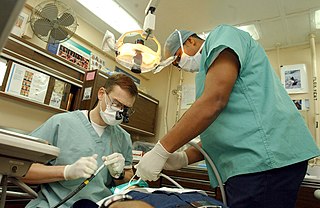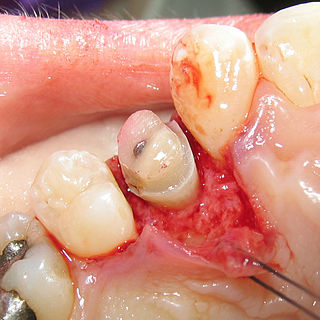
A dentist, also known as a dental surgeon, is a health care professional who specializes in dentistry, the branch of medicine focused on the teeth, gums, and mouth. The dentist's supporting team aids in providing oral health services. The dental team includes dental assistants, dental hygienists, dental technicians, and sometimes dental therapists.

The gums or gingiva consist of the mucosal tissue that lies over the mandible and maxilla inside the mouth. Gum health and disease can have an effect on general health.
Cosmetic dentistry is generally used to refer to any dental work that improves the appearance of teeth, gums and/or bite. It primarily focuses on improvement in dental aesthetics in color, position, shape, size, alignment and overall smile appearance. Many dentists refer to themselves as "cosmetic dentists" regardless of their specific education, specialty, training, and experience in this field. This has been considered unethical with a predominant objective of marketing to patients. The American Dental Association does not recognize cosmetic dentistry as a formal specialty area of dentistry. However, there are still dentists that promote themselves as cosmetic dentists.
Periodontology or periodontics is the specialty of dentistry that studies supporting structures of teeth, as well as diseases and conditions that affect them. The supporting tissues are known as the periodontium, which includes the gingiva (gums), alveolar bone, cementum, and the periodontal ligament. A periodontist is a dentist that specializes in the prevention, diagnosis and treatment of periodontal disease and in the placement of dental implants.

A dental extraction is the removal of teeth from the dental alveolus (socket) in the alveolar bone. Extractions are performed for a wide variety of reasons, but most commonly to remove teeth which have become unrestorable through tooth decay, periodontal disease, or dental trauma, especially when they are associated with toothache. Sometimes impacted wisdom teeth cause recurrent infections of the gum (pericoronitis), and may be removed when other conservative treatments have failed. In orthodontics, if the teeth are crowded, healthy teeth may be extracted to create space so the rest of the teeth can be straightened.
Laser surgery is a type of surgery that cuts tissue using a laser in contrast to using a scalpel.

Gingival recession, also known as gum recession and receding gums, is the exposure in the roots of the teeth caused by a loss of gum tissue and/or retraction of the gingival margin from the crown of the teeth. Gum recession is a common problem in adults over the age of 40, but it may also occur starting in adolescence, or around the age of 10. It may exist with or without concomitant decrease in crown-to-root ratio. 85% of the world population has gingival recession on at least one tooth with denuded root surface ≥1.0 mm.
A dental laser is a type of laser designed specifically for use in oral surgery or dentistry.

Crown lengthening is a surgical procedure performed by a dentist, or more frequently a periodontist, where more tooth is exposed by removing some of the gingival margin (gum) and supporting bone. Crown lengthening can also be achieved orthodontically by extruding the tooth.

Scaling and root planing, also known as conventional periodontal therapy, non-surgical periodontal therapy or deep cleaning, is a procedure involving removal of dental plaque and calculus and then smoothing, or planing, of the (exposed) surfaces of the roots, removing cementum or dentine that is impregnated with calculus, toxins, or microorganisms, the agents that cause inflammation. It is a part of non-surgical periodontal therapy. This helps to establish a periodontium that is in remission of periodontal disease. Periodontal scalers and periodontal curettes are some of the tools involved.
Gingivectomy is a dental procedure in which a dentist or oral surgeon cuts away part of the gums in the mouth.

A frenectomy is the removal of a frenulum, a small fold of tissue that prevents an organ in the body from moving too far. It can refer to frenula in several places on the human body. It is related to frenuloplasty, a surgical alteration in a frenulum. Done mostly for orthodontic purposes, a frenectomy is either performed inside the middle of the upper lip, which is called labial frenectomy, or under the tongue, called lingual frenectomy. Frenectomy is a very common dental procedure that is performed on infants, children, and adults. A similar procedure frenulotomy is where a tight frenulum may be relieved by making an incision in the tight tissue.

An impacted tooth is one that fails to erupt into the dental arch within the expected developmental window. Because impacted teeth do not erupt, they are retained throughout the individual's lifetime unless extracted or exposed surgically. Teeth may become impacted because of adjacent teeth, dense overlying bone, excessive soft tissue or a genetic abnormality. Most often, the cause of impaction is inadequate arch length and space in which to erupt. That is the total length of the alveolar arch is smaller than the tooth arch. The wisdom teeth are frequently impacted because they are the last teeth to erupt in the oral cavity. Mandibular third molars are more commonly impacted than their maxillary counterparts.
Dental pertains to the teeth, including dentistry. Topics related to the dentistry, the human mouth and teeth include:

A jaw abnormality is a disorder in the formation, shape and/or size of the jaw. In general abnormalities arise within the jaw when there is a disturbance or fault in the fusion of the mandibular processes. The mandible in particular has the most differential typical growth anomalies than any other bone in the human skeleton. This is due to variants in the complex symmetrical growth pattern which formulates the mandible.
Hereditary gingival fibromatosis (HGF), also known as idiopathic gingival hyperplasia, is a rare condition of gingival overgrowth. HGF is characterized as a benign, slowly progressive, nonhemorrhagic, fibrous enlargement of keratinized gingiva. It can cover teeth in various degrees, and can lead to aesthetic disfigurement. Fibrous enlargement is most common in areas of maxillary and mandibular tissues of both arches in the mouth. Phenotype and genotype frequency of HGF is 1:175,000 where males and females are equally affected but the cause is not entirely known. It mainly exists as an isolated abnormality but can also be associated with a multi-system syndrome.
Laser gingivectomy is a dental procedure that recontours or scalpels the gingival tissue to improve long term dental health or aesthetics. Compared to conventional scalpel surgery, soft-tissue dental lasers, such as laser diode, Nd:YAG laser, Er:YAG laser, Er,Cr:YSGG laser, and CO2 lasers, can perform this procedure, offering a precise, stable, bloodless, often less painful, and accelerated healing experience. However, the laser diode gained more popularity due to its versatility, less interaction with hard tissue, ease of use, and the less expensive set up.

Gummy smile, also known as excessive gingival display, is a smile that shows gum under the upper lip. It is a common clinical condition, which can be caused by an abnormal dental eruption, hyperfunction of the upper lip elevator muscle, excessive vertical growth of the maxilla bone, over-eruption of the maxillary anterior teeth, or a combination of the above described factors. Several treatment options have been proposed to enhance the smile display and to reduce the gingival exposure.

In periodontology, gingival grafting, also called gum grafting or periodontal plastic surgery, is a generic term for the performance of any of a number of surgical procedures in which the gingiva is grafted. The aim may be to cover exposed root surfaces or merely to augment the band of keratinized tissue.
Periodontal surgery is a form of dental surgery that prevents or corrects anatomical, traumatic, developmental, or plaque-induced defects in the bone, gingiva, or alveolar mucosa. The objectives of this surgery include accessibility of instruments to the root surface, elimination of inflammation, creation of an oral environment for plaque control, periodontal disease control, oral hygiene maintenance, maintaining proper embrasure space, addressing gingiva–alveolar mucosa problems, and esthetic improvement. Surgical procedures include crown lengthening, frenectomy, and mucogingival flap surgery.










